
Donna Huanca: “Gravity is overrated”
An interview with Berlin-based American artist Donna Huanca, whose show UTOPIC CELLS is on view in the 1,200 m² space of the Zuzeum Art Centre until November 24th
This fall, the Zuzeum Art Centre in Riga opened UTOPIC CELLS, a solo exhibition by Berlin-based American artist Donna Huanca. This multi-sensory project incorporates painting, sculpture, video, sound, and scents. UTOPIC CELLS marks the artist’s most comprehensive, large-scale, solo institutional exhibition in the Baltics. The show presents a multi-dimensional landscape guiding the viewer through a translucent, biodegradable membrane that creates a new architecture within the open plan of Zuzeum. When you enter this space, you hardly recognize it, even if you've been here many times before.
UTOPIC CELLS. 2024. Photo: Ansis Starks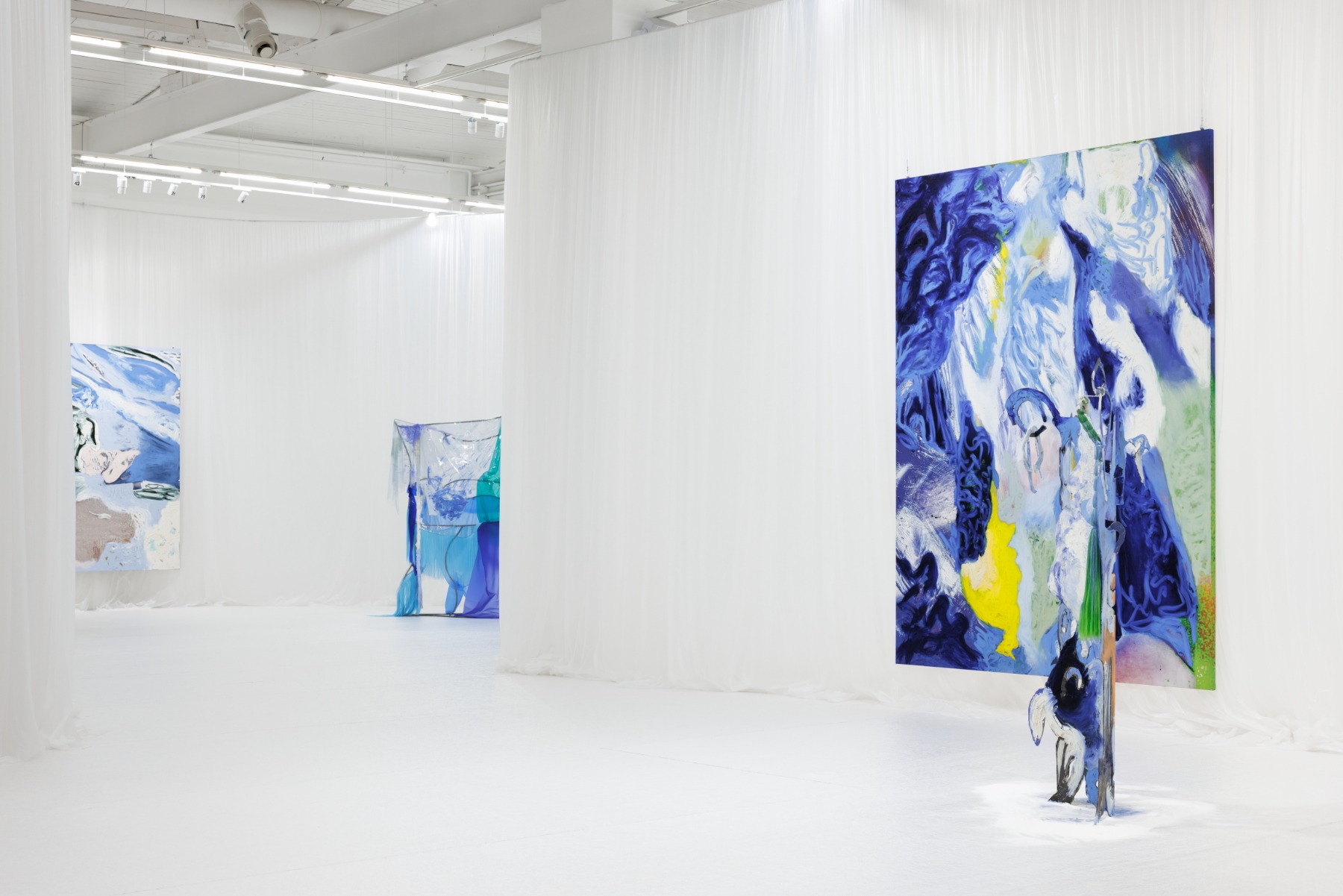
White floors covered with specially commissioned material, white curtains hanging like frozen giant white waves or spirals, create a sense of a pristine space, open to us as if from a blank slate. Against this backdrop, Donna Huanca's works—intensely saturated with color—appear especially vivid and striking. However, Donna herself never paints on white space, on a blank square canvas. It doesn’t inspire her. Her method is different, and it crystallized more then ten years ago when she began painting on bodies – specifically, on the bodies of her performers. These living sculptures appeared temporarily and later disappeared under the streams of showers that washed the paint off their bodies. But Donna Huanca managed to photograph the fragments of body painting that were most interesting to her – the way the pigment and clay behaved on the skin. These fragments were later printed in much larger formats, and it was these prints that became Donna's canvases, on which she would hand-paint and mix colors.
Donna Huanca in her Berlin Studio. Photo: Tobias Willmann. Courtesy Peres Projects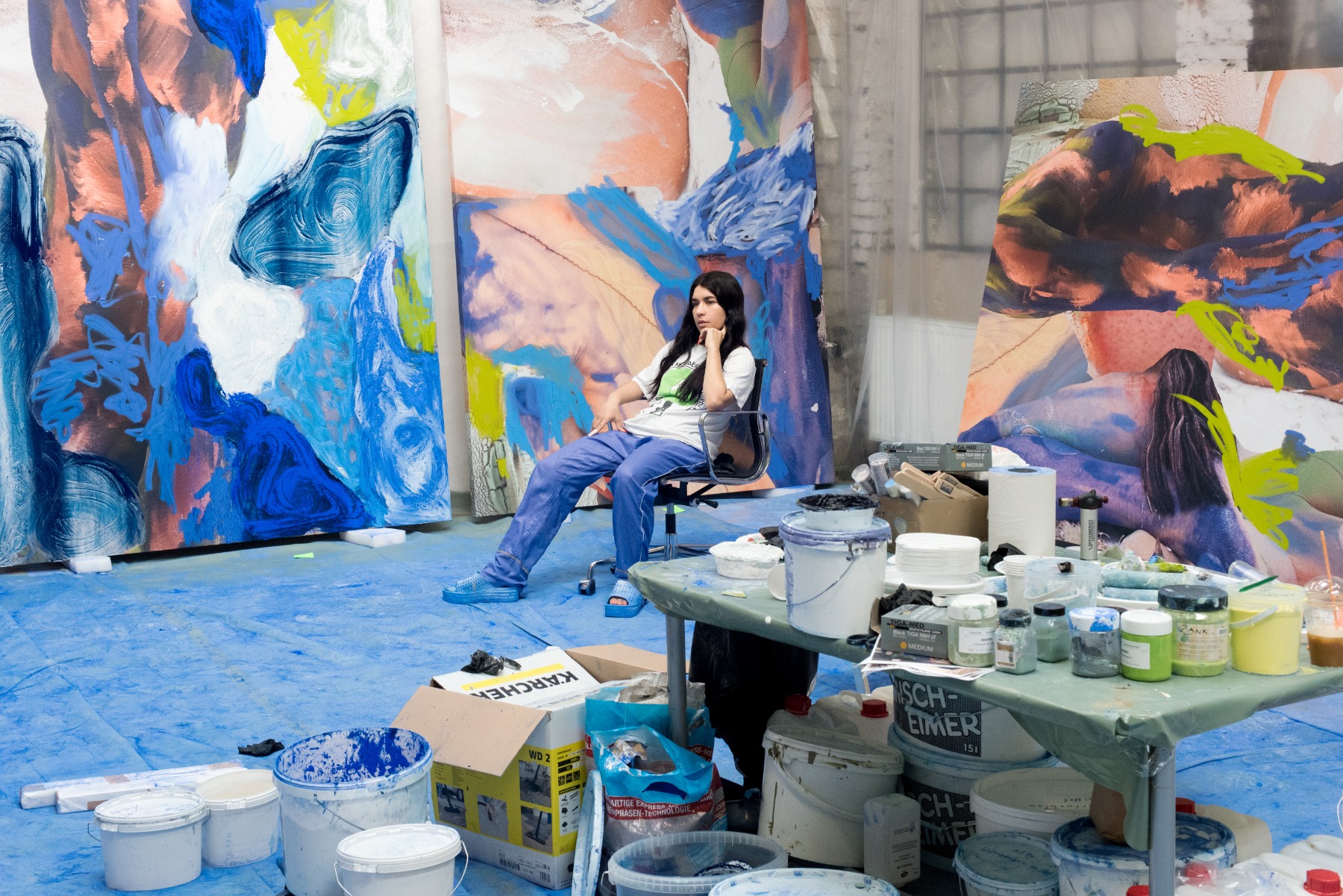
“Everything always goes back to the body, ” she says. "And that's such an important part for me to start, because I feel like everything I do is collage work. It's based on taking something and combining things that don't necessarily belong together. The paintings wouldn't exist without the live body. I’m not really interested in painting on something that has no history or is just blank.”
UTOPIC CELLS is both a retrospective of works from previous years (including pieces that are part of the Zuzeum collection) and entirely new works. In a sense, this exhibition is a continuation of the project that was realized at the Riga Art Center Kim? in 2015. At that time, Donna Huanca exhibited alongside the Ethiopian-American artist Ezra Wube and worked with few female performers on whose bodies she painted. It was then that we met for a brief interview, during which we discussed how her background and childhood may have influenced her art.
POLYSTRENE BRACES. Kim? 2015. Photo: Ansis Starks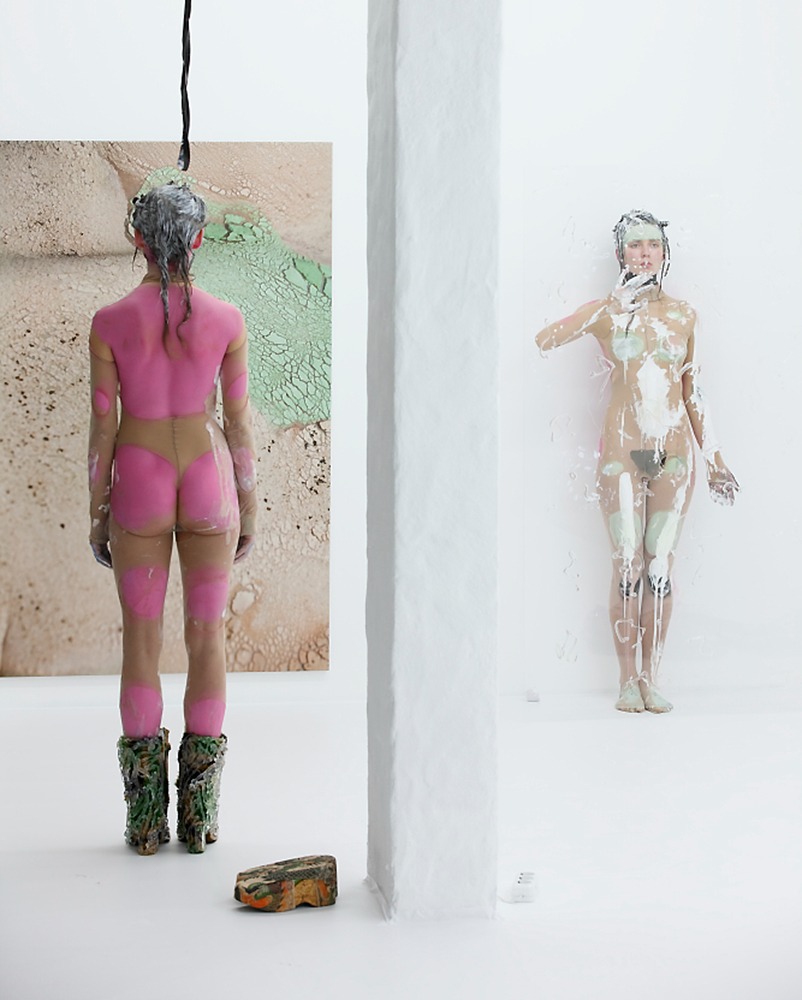
“I was born in Chicago; my parents immigrated to the USA just before my birth,” she told me. “When I was a child, every summer we would go to Bolivia. But even in Chicago, it was like living in a bubble. My parents were always thinking about returning; that idea was always present. At home, we only spoke Spanish. It felt like, once we stepped inside, the USA ceased to exist. Outside, at school, on the streets, it was a completely different, American reality. And I tried really hard to find connections between these two worlds – the world of my parents and the culture they came from, between my genetic memory and the reality that surrounded me outside of home.” At the same time, Donna avoided a direct connection between this context and how she expresses herself as an artist. “When I show my work, I often get questions like, "Do I choose bright, light tones specifically because of my family and background?" And I feel a bit trapped by this. As if I can't use them just for the sake of it –no, I must do it because of my particular background. I don’t think the connection is that direct. At the very least, I try to draw from both contexts, rather than just follow one.”
UTOPIC CELLS. 2024. Photo: Ansis Starks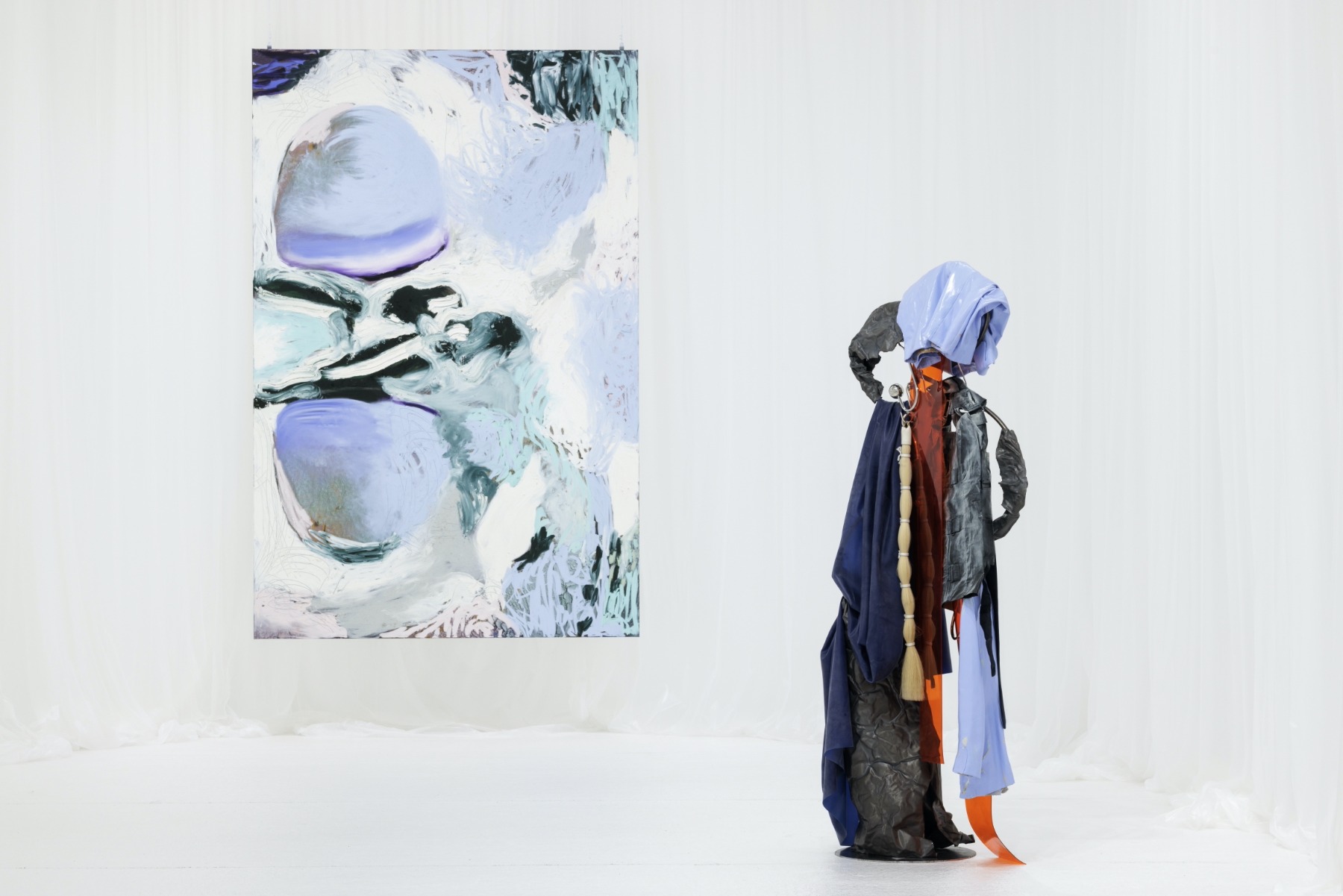
Similarly, she is quite critical of attempts to trace the roots of her fascination with the color blue to the works of Yves Klein or other artists from recent history. “She is less inspired by the contemporary art world than she is by history and experience — nightclubs, for instance, or even history museums”, сritics write about her. But despite all her interest in history, her art is undoubtedly oriented towards the future. “I try to project a future, to experiment with visions of what a feminized future would look like, what it would value. For me, that looks like care, trust, community, the natural world, and the interconnectedness and dependence of bodies with the natural world”.
And so, meeting again after nine years, we discussed the past and the future, memories and hair, scents and sounds, as well as the microcosm of her exhibition at Zuzeum while sitting on one of the plush sofas in the lobby of the art center. Donna spoke with confidence, listened intently, and openly described how her art is created, layer by layer.
Donna Huanca. NEURAL GLITCH, 2019. Painting - Oil, sand on digital print on canvas.
275 x 180 cm
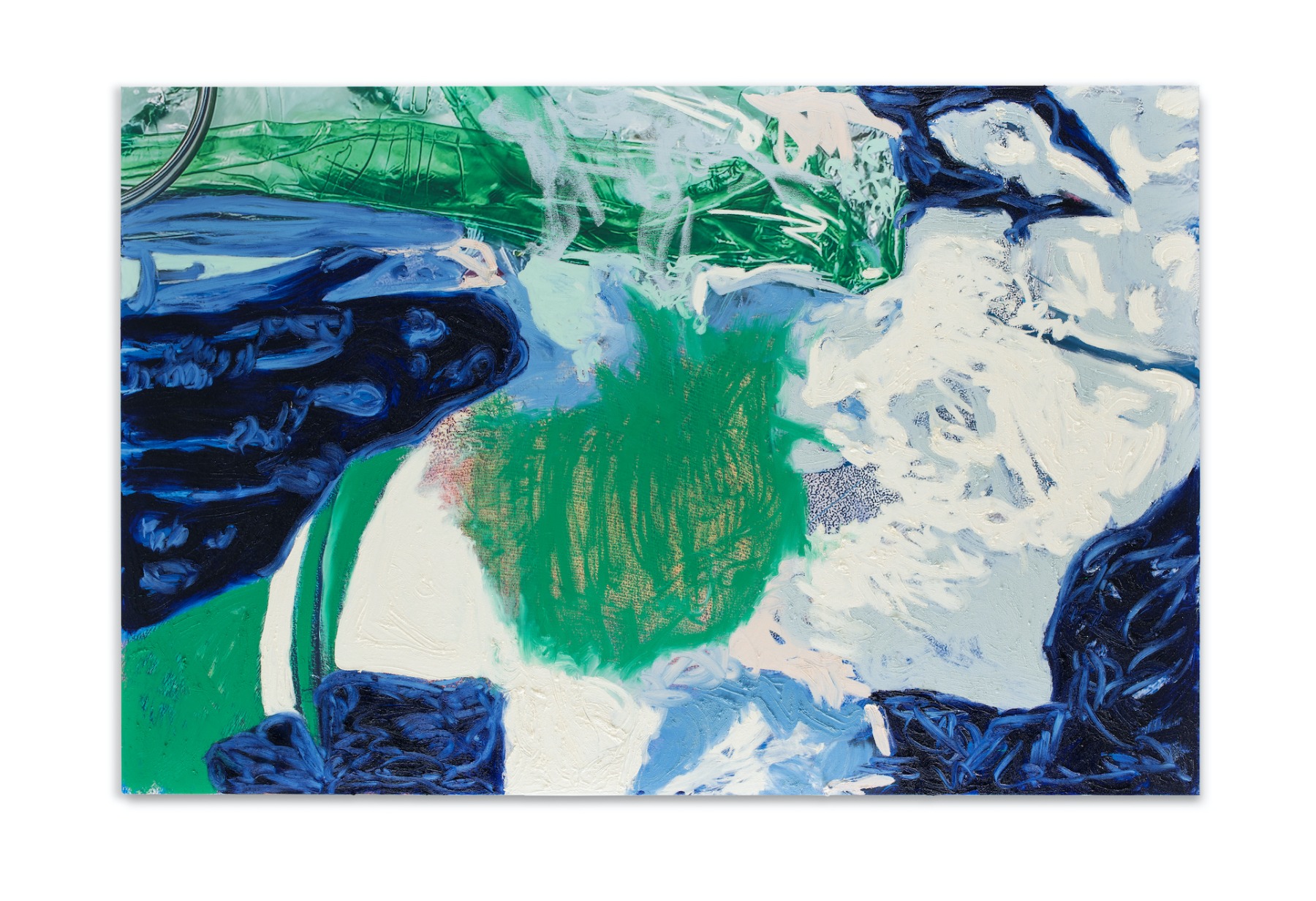
We first spoke with you in 2015 during your first visit to Riga when you exhibited with Ezra Wube at the art center Kim? And now a new show featuring 29 works in a 1,200 m² space…
That time marked the beginning of my focus on performance art. There was a performance element in that show, and since then, my work has often begun with it. And then all of these relics have come out of the performance element. However, in this current show, there’s no live performance. Yet, it still feels as though there's a lot of movement due to all the materials that are rooted in that practice of live performance.
Typically, whenever I have a show, I create entirely new pieces in response to the space, architecture, and location. But for this show, I did something different. I revisited my archive and selected 29 works, spanning sound, scent, video, painting, and sculpture. Some of the pieces are really early works, dating back to 2016 and 2017. I wanted to present them within a kind of "soft architecture", that changed the rules of normal geometry. Because the exhibition space is a former factory. When I first arrived, I was struck by the complexity of the ceilings – there was so much information there. So I wanted to create this kind of soft architecture that was very ethereal and almost invisible and very hazy. That would kind of disorient the person walking through it and layer different time zones. As I’m combining here works made at different times and with various materials, I wanted to create a kind of plane, like sculpting with time.
There is also a mirrored gate at the center, which acts as the nucleus of the exhibition. It’s the most recent work and also embodies this idea of layered time. I’ve taken indigenous iconography and carved it into the mirror. The reflective surface constantly updates itself based on its surroundings, showing new environments or people in front of it. In this way, the piece is never static – it reflects its context back at the viewer. What’s also unique about this piece is that it’s made from a single material – stainless steel – which is rare for me. I typically work with a variety of collected materials, so this simplicity was a shift in my process. I really like the piece, and I’m still exploring its full meaning.
UTOPIC CELLS. 2024. Photo: Ansis Starks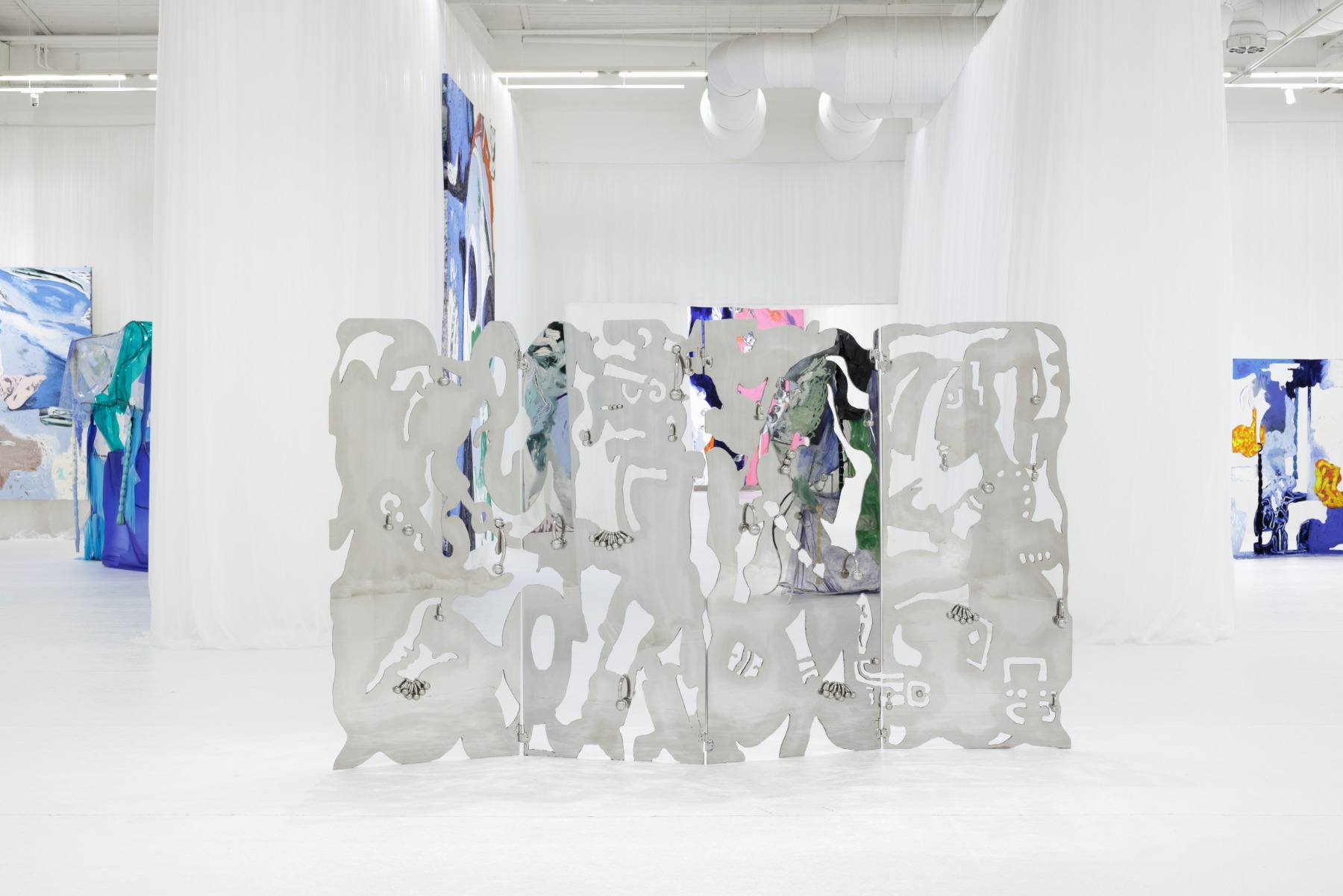
But this piece also incorporates metallic piercing forms. Why are they there?
With all of my works, everything is connected to the body. The one universal experience we all share is being trapped in a body that’s decaying and dying. Because of that, I like to work with materials related to the body. In this case, the forms can be seen as jewelry or as a kind of scarification, referencing how humans have always decorated and altered their bodies.
I also love using hair in my work because it's such an interesting material. It acts as a collector of information. Hair records everything – traumas, drugs, experiences – almost like a personal history embedded in a strand. As a woman, I see hair as a sort of antenna. Culturally, women are allowed to have long hair, whereas masculinity is often associated with having less or no hair. Hair also serves as a reminder of aging, continuation, and the passage of time. In a way, hair represents time itself, and that’s one of the reasons I’m drawn to it.
UTOPIC CELLS. 2024. Photo: Dasha Trofimova
But in your works, we see hair only as a material, only as an object. We cannot really read what is recorded inside.
All of the materials I collage at the end become like a one common material out of many. But I find the presence of hair to be very powerful, and its length adds to that impact. In this show there’s a variety of types: horse hair, real hair, fake hair, and different colours. It’s also incorporated into the paintings. For me, hair serves as a fundamental conceptual material, referencing the idea of time and the recording of events.
Donna Huanca. PMA. 2017. Peres Projects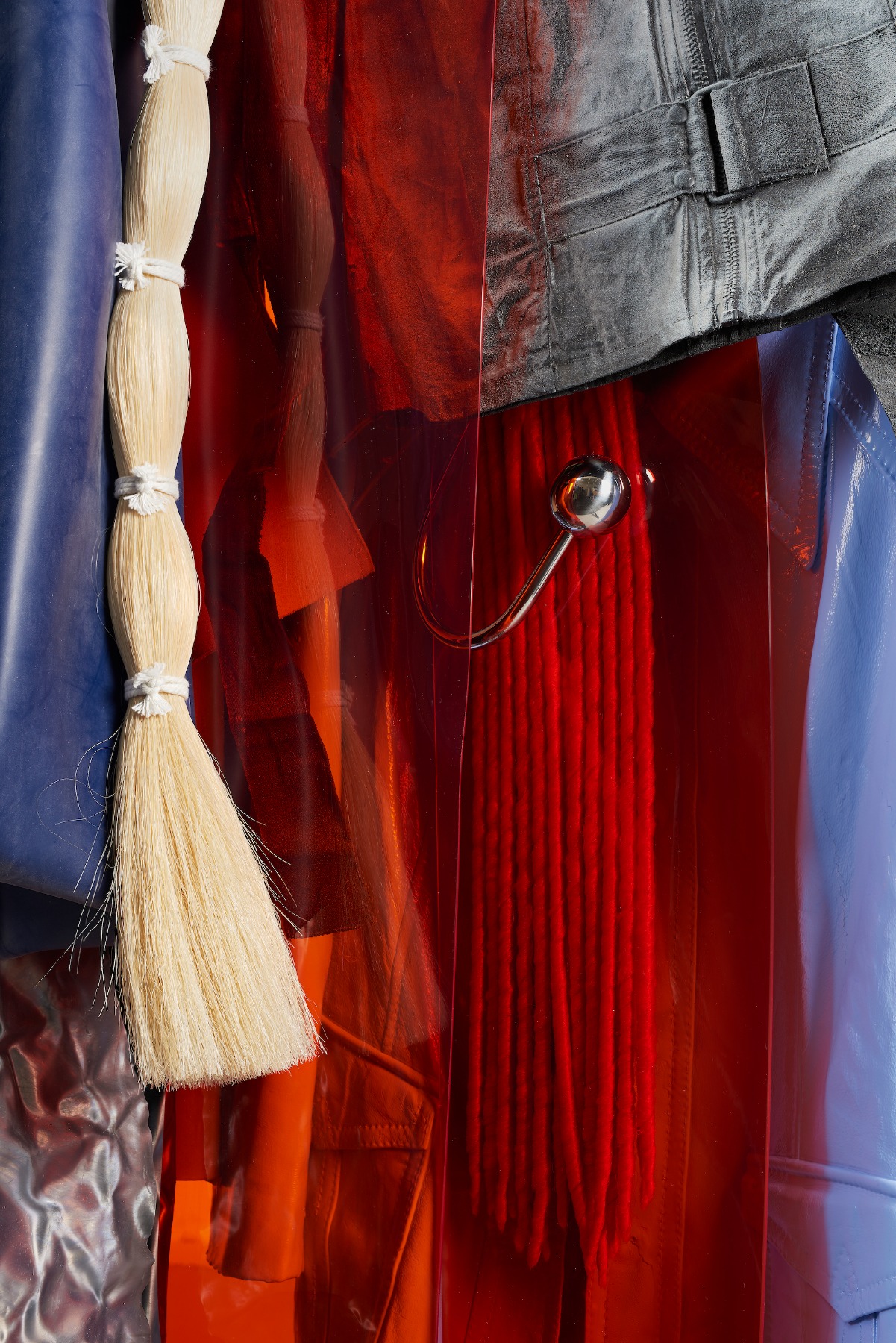
Like tape-machines…
I also think about recording devices like quipus, ancient Inca relics. Instead of using words, they used knots in threads to convey information. These knots functioned as accounting tools and storytelling devices, creating a form of communication that transcends language. I find this concept intriguing because it represents a form of communication that is more visceral and direct. This is similar to what I aim for in my work – creating or referencing things that communicate beyond words. Visual art, to me, is about presenting ideas that can be interpreted in many ways across different languages, capturing the essence of the human experience.
But you also have some works made from clothes and fabrics here. Were these clothes part of any performances?
A lot of the clothes used in these works were either my own or were worn during performances. Sometimes, they were my clothes, then used in performances, and later incorporated into sculptures. When I create objects for performers to wear, they are often made quickly and not intended as permanent clothing. However, I may later repurpose these items into new sculptures, such as the plastic collages and hair pieces. These sculptures consist of materials that were once on bodies.
Additionally, there are three tablets in the video room made of stainless steel. I think of them as planets or scrolls, and they are decorated with performers’ outfits. The performers wear nylons that I paint, and after they take them off, I like to think that their DNA or personal history is embedded in them. I then save these nylons and use them in the sculptures. I fold them and create new, ethereal sculptures. The paint is embedded in this material, and as it stretches, the particles fall off, turning into dust. I like working and getting lost with materials and textures.
UTOPIC CELLS. 2024. Photo: Ansis Starks
As you said before that there are a lot of materials which at the end became one. And here in the space you use also sound and the scent of palo santo tree.
It's a collage of many different things, but that's like the base scent. My references were inspired by the idea of a fire that had just gone out. I often reflect on the origins of where I'm supposedly from, South America, and I started looking into cleansing herbs and woods that are believed to purify auras. I wanted to create an experience that felt like a symbolic cleansing or a ‘shower’ before entering the show, allowing viewers to feel more attuned. Scent is such a powerful tool – it can manipulate how we perceive and feel things, and it’s a strong trigger for memory. So, I aimed to cleanse the viewer’s senses before they see the show while also giving them something to remember. It's more of a bodily reaction than just a visual one. I want the experience to create a deeper memory, beyond just the visual elements like the white floor.
UTOPIC CELLS. 2024. Photo: Dasha Trofimova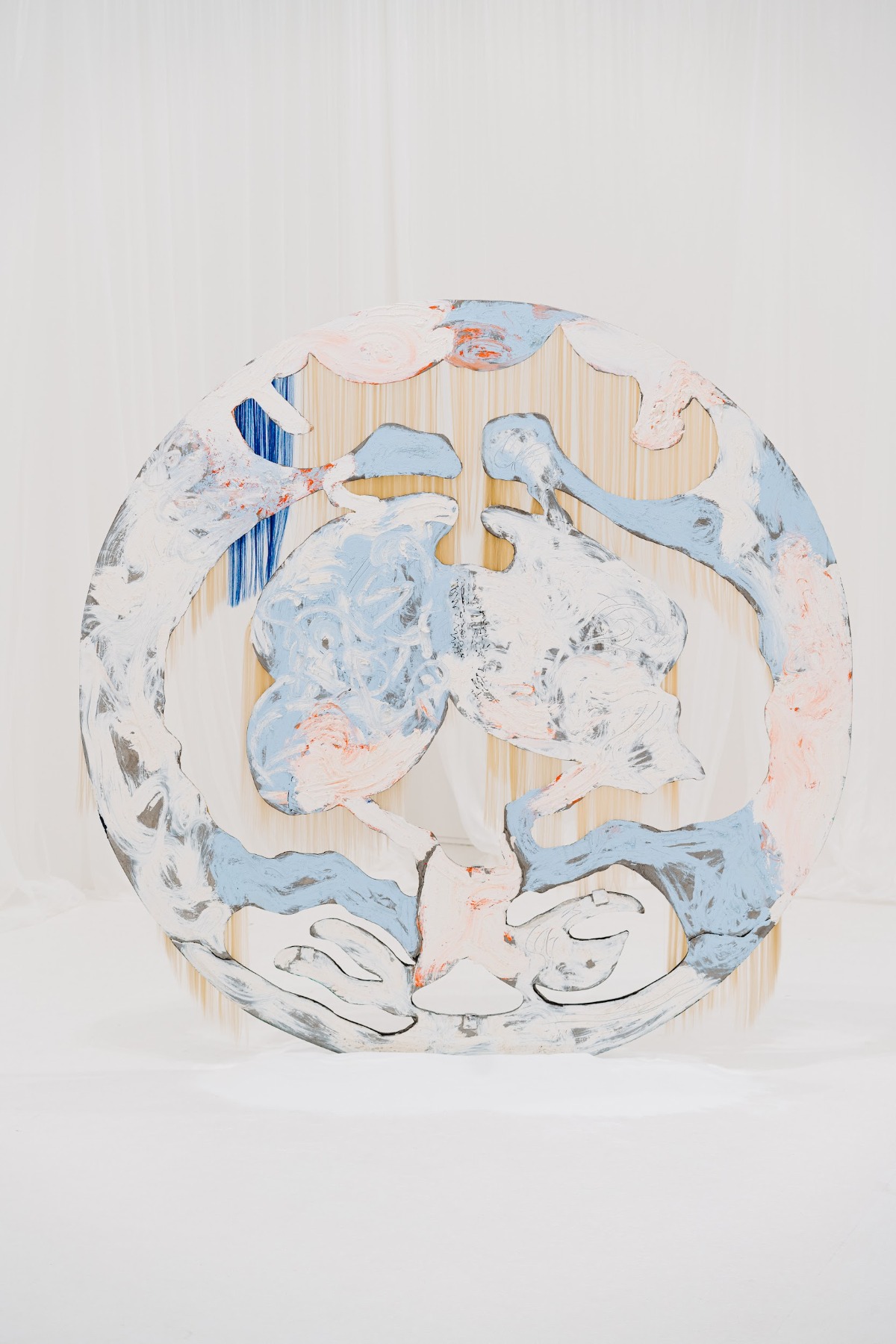
And the sound... I think I heard something like a cat's purr.
Yes, I also collage different natural sounds, voices of various animals, and elements. This particular piece is an hour long and is divided into four sections: air, earth, water, and fire. I feel like that’s also what this show is about: reducing things to their essential elements and abstracting them so you can examine them, almost like in a laboratory.
In past shows, I’ve used directional speakers, placing sounds in different areas so they move with you and disorient you by coming from various directions and dimensions. But in this show, since the architecture is already so immersive, we decided to let the sound flow evenly throughout the space. I think it works well that way.
The exhibition is titled UTOPIC CELLS. How do you interpret this concept? Why “cells” and why “utopian”?
When I choose titles, I think of them as playing with words, like combining words that don’t normally belong together, almost like naming an album. UTOPIC CELLS is a bit of an oxymoron. “Cells” can refer to something confining, like prison cells, or the building blocks of life, the cells that make up the body. On the other hand, “utopian” refers to an idealized world, something we’re always striving for but often fall short of as humans, since we tend to mess things up or destroy them.
In this context, the cells represent spaces where you can focus on something that might otherwise go unnoticed, like examining it in a laboratory. Even though there are 29 works in the show, which is quite a lot, I wanted to create a feeling of emptiness and space – an atmosphere where you can really experience and contemplate each piece. Some of the “cells” are small, just 2 or 3 meters wide, designed to be viewed by one person at a time, while others are more open. I thought of the floor plan almost like an intestine, inviting you to move deeper into the space and have different moments with each work.
Courtesy Peres Projects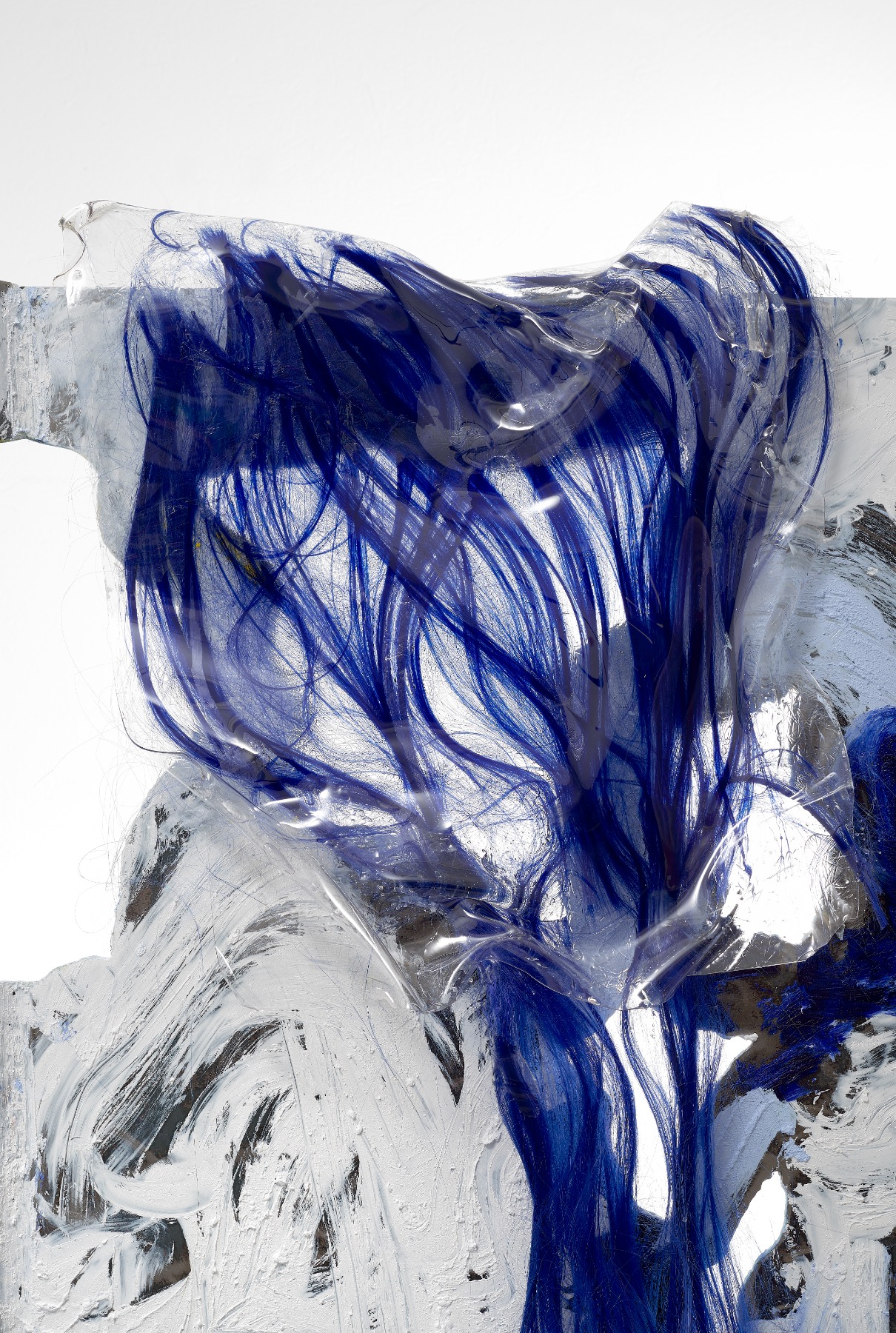
There are so many colors and vivid impressions in your work. Do you have any favorite colors that you use more than others? And do these choices sometimes come from your Bolivian background or the impressions you got while visiting this country?
I think in our past interview in 2015, I mentioned that it’s easy to explain the colors in my work by referencing memories of explosions of color, particularly from Bolivia. But, essentially, I aim for my work to be meditative, both for myself and the audience, even though there's often chaos in it. Some pieces have very neon or artificial-looking colors, but they’re actually all colors you can find in nature. I do love observing beautiful color combinations in things like birds or rocks – I'm always collecting rocks – but I’m not consciously trying to reference anything specific. It’s more about absorbing the surroundings and creating something that feels necessary to me.
In my studio, I have a lot of colors, and I just play with them. I don’t use a paintbrush, I paint with my hands – it’s very visceral and fast. I use a big oil stick, and the rest is all hand-painted. Underneath the paintings are collaged photographs of performers' bodies. When I paint on them for the performance, it’s very intuitive, I don't think about what I'm doing. And then I'll find beautiful moments within the whole body, and frame a zoom-in of the body. Yes, this is a really beautiful painting, but it's just, like, 5 cm in diameter. So I zoom in, make a photo, and then I print that image and paint over it.
So, you change the scale.
The scale is really different. I often blow it up because I want the work to feel immersive, like you can enter it and experience a new world. The smallest painting I’ve done is about 150 cm, which isn’t much smaller than my height of 162 cm. I want the pieces to feel like portals where viewers can get lost.
Donna Huanca. VULPINAS HAIR WASH, 2023. Painting - Oil, sand on digital print on canvas. 400 x 300 cm
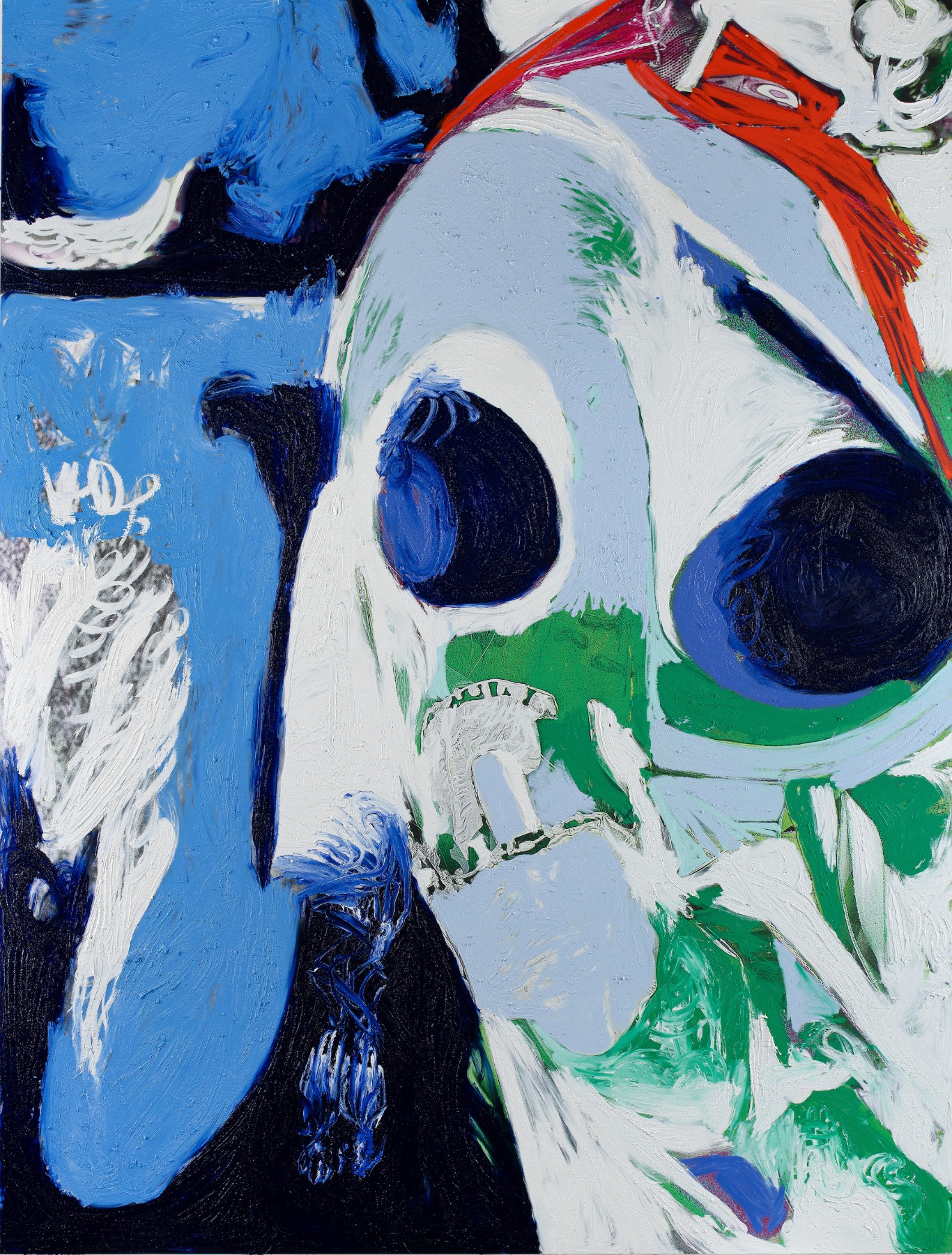
And you never draw on just white canvas?
No, I can’t. That’s the hardest thing for me to do. I don’t know how people manage it. I’ve avoided being a painter for so long; when I was in school, I was turning in sound pieces and creating sculptures. Even the show you saw at Kim? featured very sculptural works. While there were things on the wall, they essentially served as props for the performance. I found my way to painting through body painting because it allowed me to create without feeling overly attached to the medium. A big white canvas feels so intimidating – it’s something I just couldn't really approach.
Maybe it's too abstract, too far from reality.
Like, what do you paint? That’s the age-old question. For me, I use my work as a reference. I’ll create a sculpture, photograph it, and then paint from that image on canvas. It’s like my sketches come to life through body painting and sculptures. Now, I’m even collaging the two. And I have a lot of fun working on the computer, but for me, that’s not where it ends – I need to have a physical experience with the work. I think that really helps make it authentic.
The relationships I build with the models are also important. Even the models I worked with here and in Riga eight years ago are still part of my life; I continue to collaborate with some of them. I like to build on those histories.
UTOPIC CELLS. 2024. Photo: Dasha Trofimova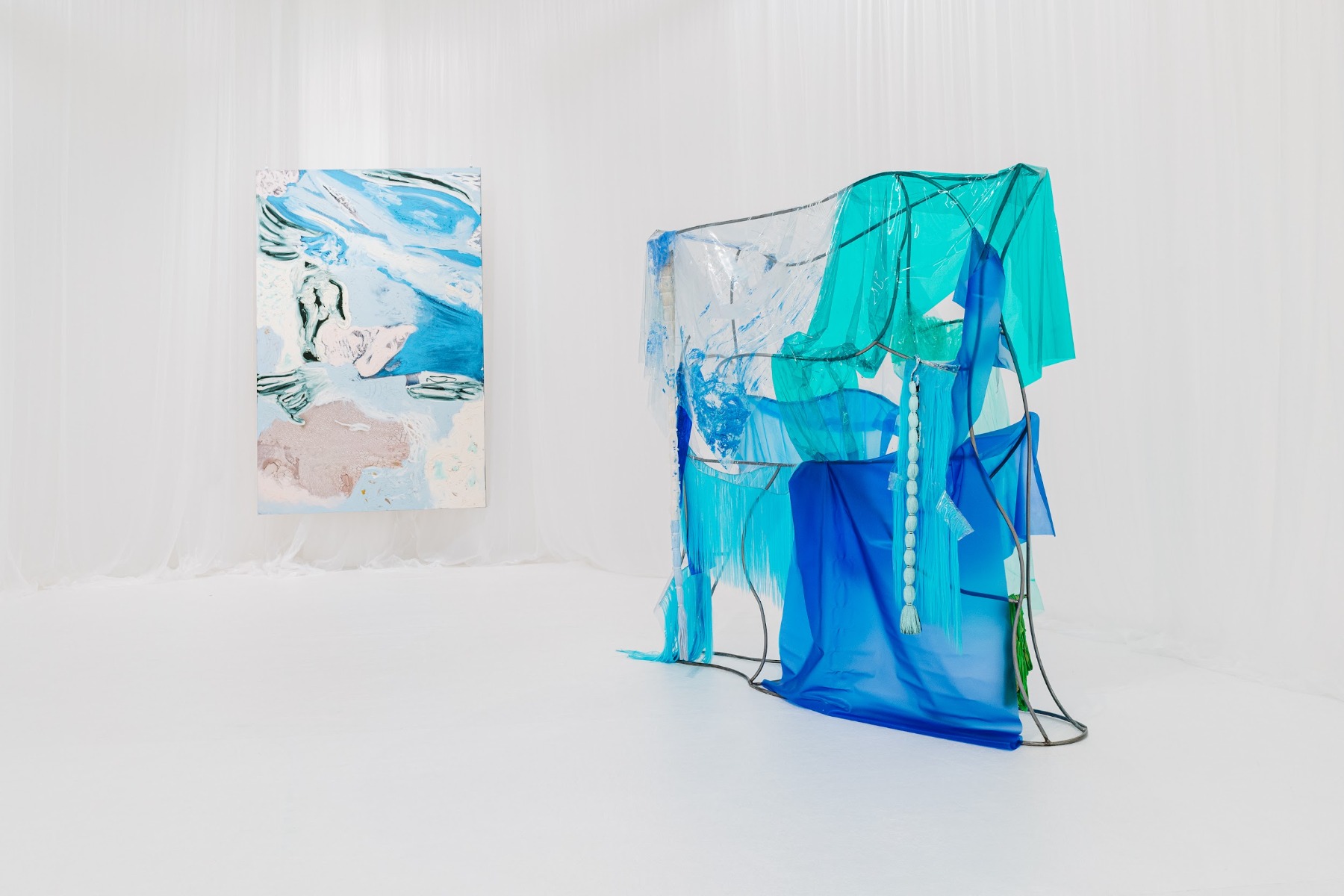
I think, altogether, it creates the impression of an ecosystem where everything is interconnected, and one element gives birth to another.
Yeah, exactly. Normally, I would just create everything new, but I thought, let’s see what it’s like to play with my old work as new collage material. This shift allowed me to look at things differently. I even like to turn paintings upside down or sideways; I don’t care about orientation. I feel like gravity is overrated, and I want to encourage viewers to see things from a new perspective.
What excited me most was looking at the show from a floor plan view. I sketched an asymmetrical face on it, which helped shape the beginning of the show by allowing me to approach it from a different angle – not just from the ground up.
I really liked one of your quotations from an interview where you said: “As a teen, the way that I would bond with people was by taking hallucinatory drugs together and we would just lose ourselves. Now I’m creating a situation that can also be like that, but in a totally sober way.”
I’m still doing that, but in a different way now. It’s nice that we can have these visceral experiences sober and in different locations. What I really want to emphasize is that this work is very human. It’s meant for everyone, regardless of education, age, or location. It’s a universal experience that can be understood by anyone, even those who don’t know much about art.
But maybe 'understood' isn’t the right word even…
No, felt, you know, felt in a way. Cause I'm not sure I understand it myself. And that's okay. I don’t feel attached to having everything figured out. My process involves making rather than explaining. I think that deeper understanding comes later, when I can’t physically create anymore, and I have the space to reflect and think.
Donna Huanca. PYROXMANGITE, 2016. Painting - Oil, acrylic and pigment on digital print on canvas. 190 x 143 cm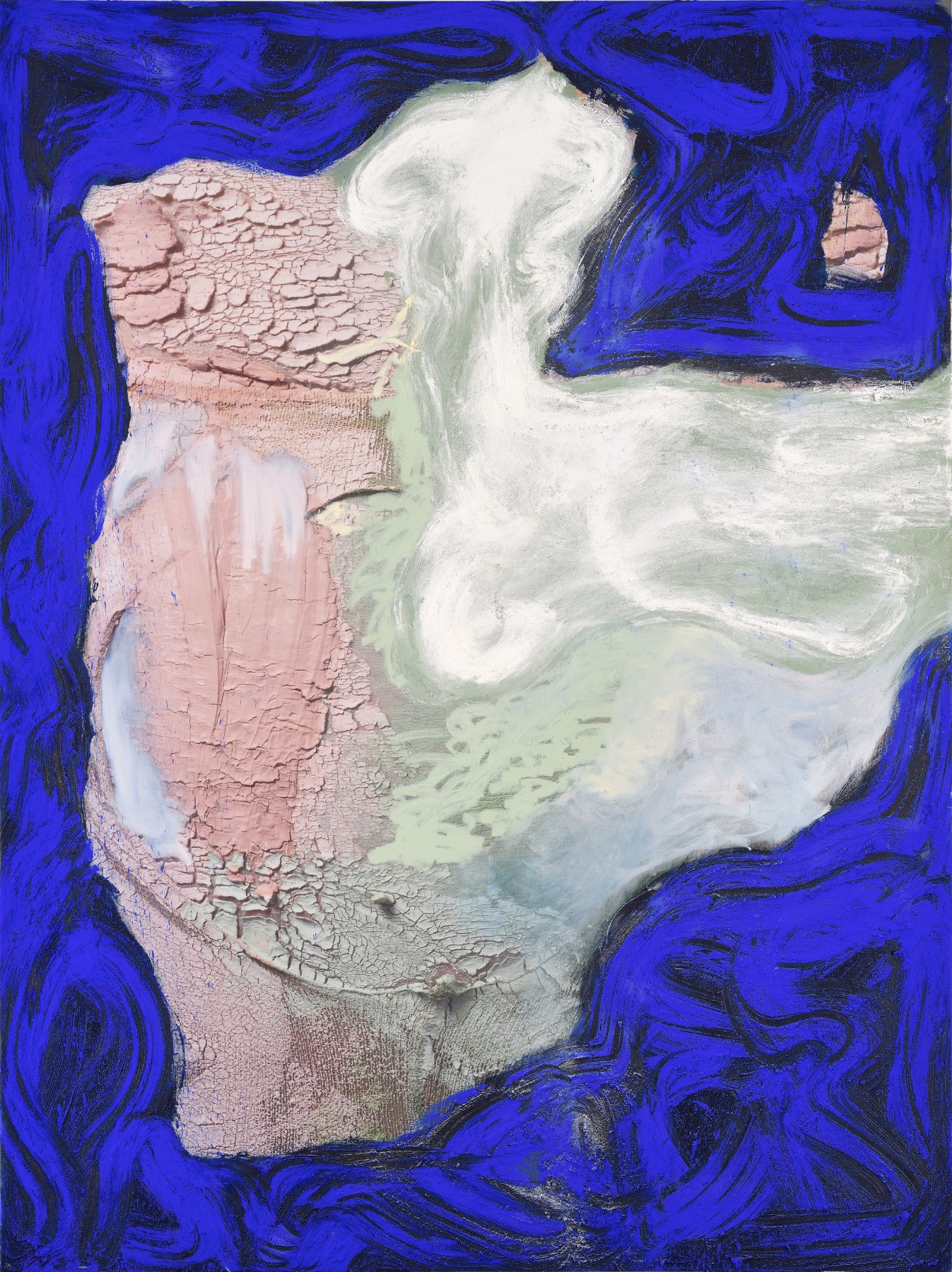
Your art also reminds me of rituals and a ritualistic way of living. Do you have your own rituals when you're working or starting a new piece?
Yes, I think it's really important to have meditation in my life, because I do have a very busy mind. I’m a bit of a hoarder – I love materials and collect a lot of things – but I believe everything has its place. I process my work by keeping everything in view in my studio. Meditation has been a significant practice for me over the years, though it’s been a bit more challenging since I recently had a baby. For me, it’s crucial to continuously seek new experiences and materials. When I have shows on this scale, it allows me to reflect on what has happened and where I am in my practice.
UTOPIC CELLS. 2024. Photo: Dasha Trofimova
Some critics argue that your art is less influenced by the contemporary art world and more by history and personal experiences, such as nightclubs, for example.
Yes, it’s true. For me, contemporary art can sometimes feel insular, often catering only to other contemporary artists. I’m much more interested in ancient art, sound, and experiential works. When you encounter something really old that still evokes a powerful response inside you, it’s incredibly impactful.
In our contemporary world, filled with distractions, it’s challenging to fully develop and finish an idea. I experience that too. While I appreciate certain contemporary artists, I find more excitement in nature, ancient art museums, or listening to music in a club. For me, those experiences offer a more direct form of communication; they engage the body rather than just the mind. I prefer to feel something before I even see it or to see something that immediately evokes a feeling. While contemporary art can certainly do that, I feel more connected to more ancient systems.
UTOPIC CELLS. 2024. Photo: Dasha Trofimova
But this ancient art… could it be anything from anywhere, or is it more connected to South American heritage?
Anything, really. Just like old forms of creation. You realize that people were thinking in a bigger, cosmic way, while now it feels like we're just trapped in technology. That’s important, obviously, but it seems to be mimicking what already exists in nature. Many of these new systems are flawed because they attempt to replicate something that has already been done. I’m not saying not to try, but it feels like a battle that needs to unfold. It’s a wait-and-see moment for me. In the meantime, we’re still human; we still have bodies, and we need to experience things. That’s what makes us feel alive. So whatever medium that may be, it’s important. We can easily get lost in technology and forget how to move, walk, and engage with our bodies.
Or forget how to eat without scrolling on the phone…
Exactly. It's crazy how we're so distracted by everything. It feels like everything's at our fingertips, but we actually don’t have time to process anything because it’s always onto the next. It's very gluttonous, you know? That’s why I think my work tries to reduce everything to a very basic level while introducing more complex ideas. Hopefully, it gives people more time to think, because that’s something we’re really missing right now.
UTOPIC CELLS. 2024. Photo: Dasha Trofimova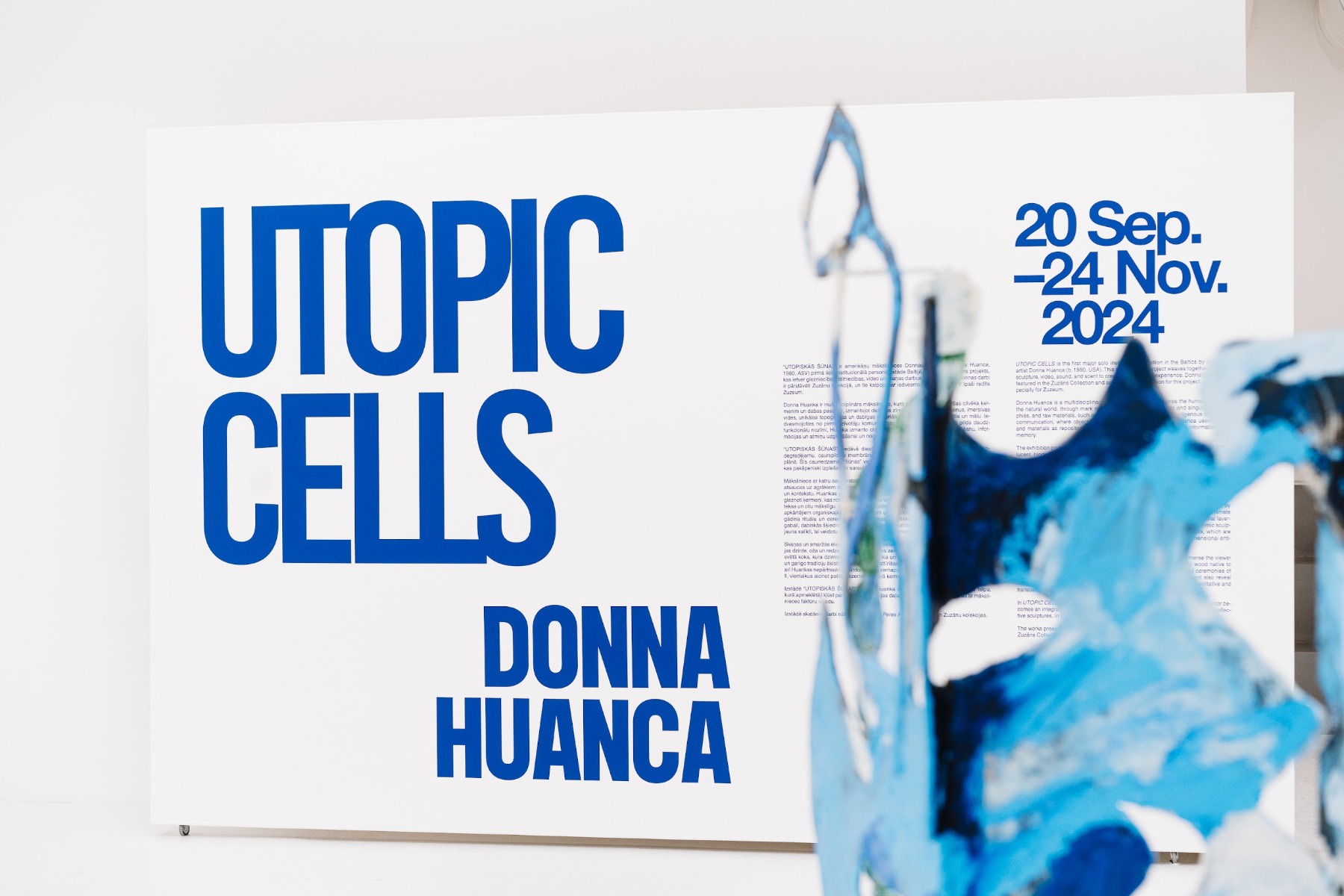
But has your sense of mission changed in these nine years? Has the contemporary world influenced you to move in a different direction than before?
I think my work has definitely shifted in the last nine years. Even when we were talking last time, I was trying to decipher the past and understand the reasons behind my choices. Was it because of my past? Now I realize it’s more about being present and looking toward the future, rather than trying to explain why things are the way they are based on genealogy or heritage. I think it goes beyond that – it's about simply being in the present. That’s the main takeaway I’ve gotten over the last ten years. In the end, they’re all just stories we tell ourselves, and we have a responsibility to create the world we live in now. I think it’s really important to stay focused on this, on present, as it makes things easier. As humans, we want to tell stories to connect with each other and explain why we are the way we are, but sometimes those categories can divide us more. That's why I think it's more important to be present and not so attached to your story of the past.
But what about the future? You are a mother now. How do you view the future? With hope or with fears?
I'm not afraid because I feel like we will figure it out. Nature will find a way, too. I know we’re entering what seems like a very scary time in the world. For me, the way to cope is by connecting with raw, basic things like nature, and taking my son to experience it as much as possible. Sharing those moments together and learning about nature feels increasingly rare; it’s easy to just put an iPad in front of a child and walk away.
Having a child also makes you realize how you contribute to society and the importance of participating in reality, which can be challenging as an artist. Living between Berlin and New York, I see how intense society is right now, especially politically. I don't know what the future holds, but I have hope. I believe in connecting with people and creating spaces where they can spread their wings. It’s important to have environments where you can relax and communicate. It's a space for healing, and it can give you a little bit of respite from the real world.